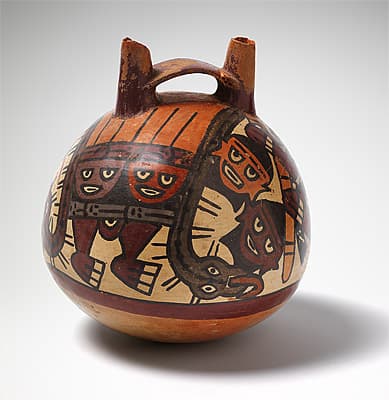NAZCA culture South coast 100 – 700 AD
Vessel with feline deity 200–400 AD ceramic17.2 (h) cm 15.4 cm (diameter) National Gallery of Australia, Canberra NGA 1984.3045 Purchased 1984
As Nazca culture reached maturity, its ceramic imagery became more complex. The trophy-head and snake vessel shows the beginning of this process, before decoration became very ornate and almost abstract in its patterning. Here the schema can be read horizontally as it winds around the almost spherical cream field of the vessel. The humanoid deity, clutching a staff and bunches of hair, wears a headdress from which four serpents emanate. Four heads with two legs, and a double-headed snake, also inhabit the image, perhaps as part of the deity’s garment.
The pot has a double spout and bridge handle, a rounded base and black line drawing. Polychrome slips are used in seven colours, showing a high level of technical expertise had been reached. Thermoluminescence testing of the ceramic gave a reading of about 375 AD,1 which fits the stylistic identification of the Middle Nazca period.
Christine Dixon
1. NGA file 84/481, tested at the Australian National University, Canberra, August 1984, no. 537.
As Nazca culture reached maturity, its ceramic imagery became more complex. The trophy-head and snake vessel shows the beginning of this process, before decoration became very ornate and almost abstract in its patterning. Here the schema can be read horizontally as it winds around the almost spherical cream field of the vessel. The humanoid deity, clutching a staff and bunches of hair, wears a headdress from which four serpents emanate. Four heads with two legs, and a double-headed snake, also inhabit the image, perhaps as part of the deity’s garment.
The pot has a double spout and bridge handle, a rounded base and black line drawing. Polychrome slips are used in seven colours, showing a high level of technical expertise had been reached. Thermoluminescence testing of the ceramic gave a reading of about 375 AD,1 which fits the stylistic identification of the Middle Nazca period.
Christine Dixon
1. NGA file 84/481, tested at the Australian National University, Canberra, August 1984, no. 537.
As Nazca culture reached maturity, its ceramic imagery became more complex. The trophy-head and snake vessel shows the beginning of this process, before decoration became very ornate and almost abstract in its patterning. Here the schema can be read horizontally as it winds around the almost spherical cream field of the vessel. The humanoid deity, clutching a staff and bunches of hair, wears a headdress from which four serpents emanate. Four heads with two legs, and a double-headed snake, also inhabit the image, perhaps as part of the deity’s garment.
The pot has a double spout and bridge handle, a rounded base and black line drawing. Polychrome slips are used in seven colours, showing a high level of technical expertise had been reached. Thermoluminescence testing of the ceramic gave a reading of about 375 AD,1 which fits the stylistic identification of the Middle Nazca period.
Christine Dixon
1. NGA file 84/481, tested at the Australian National University, Canberra, August 1984, no. 537.


